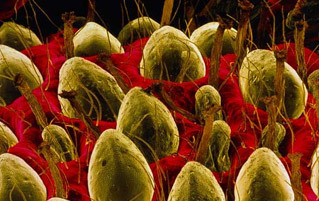7 Normal Things That Become Horror Movies Under a Microscope

Nature is a beautiful, precious thing that brings nearly as much joy as it does painful, horrific death, yet we always talk about "getting back to nature" as a positive experience. That's all well and good. Just don't get too close, because once you whip out a microscope, some truths cannot be unknown.
A Strawberry Is a Hellish Alien Hive

At Normal Size ...
Whether you eat them as jam, with cream, or covered in chocolate, strawberries are not only delicious, but kind of oddly sexy. There's no movie scene that zooms up to a woman's lips as she takes a seductive bite of a raw potato, after all.

Potatoes do nothing for our vampire fetish.
But Up Close ...
Put a strawberry under an electron microscope and suddenly it's a production still from the gritty reboot of Aliens:

They're warm. They're pulsating.
Those white egg-like structures are actually the strawberry pips, which are called achenes. They're the true fruit of the strawberry plant, lounging around in the fleshy leftover carrier blob that we have taken to eating. The hairs are there because strawberries just happen to have hair.
Straight up hair.
A Pop-Tart Looks Like a Sci-Fi Virus

At Normal Size ...
Odds are that at some point in your life you have eaten no fewer than two of the paste-filled cardboard rectangles known as Pop-Tarts. If you insist you've only eaten one at any given time, you are a liar and have deep personal issues to explore instead of reading this article. Godspeed.
But aside from the ingredient list, ain't nothin' scary about a Pop-Tart.

Plus it works with any diet because it's not technically food.
But Up Close ...
Bring a Pop-Tart under an electron microscope, magnify it 30,000 times, and you'll find yourself facing terror itself.

Whatever you do, don't inhale.
That fungal cancer cell collection up there is pretty far from a delicious, sugary treat. That's something a team of space marines would hose down with fire, or maybe the background of some particularly deranged horror video game level. If this was a Hollywood film, a serious man in a white coat would take one look at that monstrosity through his microscope and say, "Dear God -- it's mutating!" while removing his glasses for emphasis. But no, that is indeed a Pop-Tart, as well as the work of photographer Caren Alpert, who uses it as an example of how messed up the chemical structure of processed food is compared to the neatly arranged geometrical structures found in nature. Does this make them taste any less delicious? No. Are you going to think of that picture -- looking for all the world like a hive of hell-spider eggs ready to burst in your mouth -- the next time you're slipping a pair of delicious Pop-Tarts out of their quarantine bag?
Probably! But that's OK -- you'll eat it anyway. It beats cookin' stuff.
Sweat Glands Are the Portals to Hell

At Normal Size ...
Sweat glands are tasked with regulating body temperature, a power they routinely abuse by also making you smell like something feet would vomit up if they had semi-functional digestive tracts. But they're just little holes in your skin, like pores, right?

When you're this close, everyone looks like Edward James Olmos.
But Up Close ...
Imagine you're in one of those movies where they shrink you down to microscopic levels so you can complete some dire mission inside the body of Martin Short. You thought you'd be taking the Short-cut through an unassuming sweat gland, but instead you find yourself staring down a portal to hell:

At the end of that tunnel is a three-headed snake, whispering your secret name.
Nah, we're just kidding. That's not actually a colored scanning electron microscope shot peering down into a human sweat gland.
Can you imagine?
No, it's looking back from the inside of the human body to your exit point as it closes up mere seconds before you return to full size in an explosion of Martin-meat. Otherwise that is an entirely accurate portrait of what your sweat gland looks like. It's also probably the reason why Ant-Man drinks so much after every mission.
Wine Is a Graveyard

At Normal Size ...
Wine is the proper way to induce inebriation in situations where other drinks, like beer or psychedelic mushroom tea, might be frowned upon. You know, like dinner at your boss's house, or ... well, no, that's pretty much the only time you should drink wine. It is the lady and/or gentleman's preferred stupid-making body-poison, and part of that has to be its look: smooth, uniform, and a deep, elegant crimson, like the blood of some majestic mythical creature. A unicorn, perhaps.

Seriously, this vampire fetish defines our whole diet.
But Up Close ...

Catch-22: To erase it from your memory, you need to drink it.
Most people are aware that yeast micro-organisms help the fermentation process of wine (and other alcoholic beverages that we shall not speak ill of here). The thing we tend to forget is that they never really go away. Photographer William LeGoullon (who has a whole portfolio of terrifying shots ruining all of your favorite things) is happy to show us the disgusting truth that lies within an innocent glass of red wine. The above microscope photo of a drop of dried wine features scores of what are most likely tiny yeast cell corpses, who have given their lives just to get you hammered enough to tolerate conversations with other human beings for the evening.
They say that scotch is the water of life, but when you drink wine, you drink death. And that's pretty metal -- maybe we need to reconsider this wine thing after all.
A Moth Proboscis Is a Golden Dragon

At Normal Size ...
This is a moth.

"Greetings, ladies and gentlemen."
This is the face of a moth:

"WHARGARBARGL."
But Up Close ...
Moths don't just have a face like an inside-out sparrow -- well, yes, they do absolutely have that, but we're going to focus on that wacky curling party favor they call a proboscis. It looks pretty harmless there. It's like the one goofy feature on an otherwise sci-fi-movie-caliber monster.

Nature makes the sweetest roller coaster designs.
With a mere 10x magnification, what was once a wacky deflated noisemaker becomes the twisted tail of some mythical golden dragon. Objectively we know that they're just tiny interlocking spines holding the proboscis structure together, but we still can't help but picture that thing spiraling up toward us from the darkness, the intermittent flashing of its scales alerting us to the true immense bulk of the beast that still hides in the void.
Or maybe moths just be lookin' crazy. We could be reading too much into this.
Zebrafish Don't Want Your Soul ... They Already Took It Ages Ago

At Normal Size ...
Zebrafish are those totally forgettable little silver-and-black things darting around at the periphery of any undersea documentary. They're the extras of the ocean, there to fill space at the edges while the camera focuses on something actually interesting. Their most notable trait is that they only cost like a dollar, so it's super easy to use them to fill your tank until you can get real fish up in that aquarium.

But just watch them get all Hollywood once they star in the Finding Nemo sequel.
Their second most notable trait is that scientists love the hell out of the li'l dudes, getting them drunk and unleashing robot predators upon them.
But Up Close ...
A mere 4.5x magnification later and ...

It's like a diseased heart opened its eyes.
Is that a monster from a '50s horror flick? Is that freaky psychedelic insect trying to hypnotize us? Is that Zorak at Burning Man? Whatever that bastard might be, we know two things: It sure as hell isn't the zebrafish we know and barely notice, and it will not find any welcome on the planet we call Earth.
But no, that is actually nature's placeholder, the zebrafish.
There is a little-known microscope technique called darkfield magnification, which creates a hollow cone of light-surrounded darkness instead of the fully lit cone most microscope work is done with. Photomicrographer James Hayden used this technique to snap a microscope photo of the zebrafish, revealing a creepy cross section of its skull. Sure, it's cheating this premise a little bit, but lean in real close to that mouth portion toward the bottom and you'll see an old Renaissance painting of the sixth circle of Dante's hell. We figured that was worth covering.
Kidney Stones Are How Nature Lets You Know It Hates You (Even More Than You Thought)

At Normal Size ...
This is a kidney stone.

A way for people to experience the joy of birth with none of the joy.
There's no polite way to phrase it: That crusty overcooked McNugget comes right out of your pee hole, and it hurts like crazy. Kidney stones can happen for a multitude of reasons, most of which presumably involve having crossed an old gypsy woman at some point. But mostly it's about not drinking enough fluids. So remember to hydrate when you mock those gypsies -- the pee hole you save might be your own!
No seriously, you do not want to experience passing a kidney stone, because ...
But Up Close ...

It's basically the movie Piranha, but in your urethra.
That's what a kidney stone looks like under an electron microscope. All those sharp edges are formed by a calcium oxalate called weddelite, which grows in crystal formations that look like something the T-1000 would morph into when you really piss him off.

Pissing him off's easy. Pissing it out's agony.
With the human eye, the structure of a kidney stone looks rough and patchy, but zoom in 250 times and you'll see the truth: They don't hurt solely because they're solid objects in your urinary tract. They hurt because they are made of razors and inside your genitals.
Evan V. Symon is a moderator in the Cracked Workshop. When he isn't trying to find evil in every famous person ever, he can be found on Facebook. He also contributed to the Cracked De-Textbook. Andrew occasionally writes and makes ska-flavored noise that you can download.
Always on the go but can't get enough of Cracked? We have an Android app and iOS reader for you to pick from so you never miss another article.
Related Reading: You know what looks crazy awesome under a microscope? Chalk. And microscopes can even make sand look unbelievably cool. For some art that was MADE to be viewed via microscope, this is the button to click.
